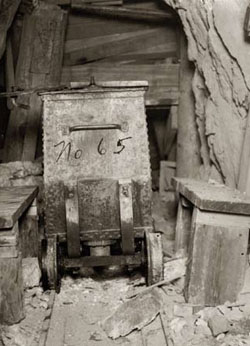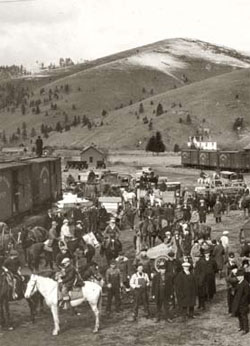Montana: Stories of the Land
Companion Website and Online Teacher's Guide
Chapter 15 - Progressive Montana, 1900-1924
Chapter 1 - Montana: Where the Land Writes History
Chapter 2 - People of the Dog Days
Chapter 3 - From Dog Days to Horse Warriors
Chapter 4 - Newcomers Explore the Region
Chapter 5 - Beaver, Bison, and Black Robes
Chapter 6 - Montana's Gold and Silver Boom
Chapter 7 - Two Worlds Collide
Chapter 8 - Livestock and the Open Range
Chapter 9 - Railroads Link Montana to the Nation
Chapter 10 - Politics and the Copper Kings
Chapter 11 - The Early Reservation Years
Chapter 12 - Logging in the "High Lonesome"
Chapter 13 - Homesteading This Dry Land
Chapter 14 - Towns Have Lives, Too
Chapter 15 - Progressive Montana
Chapter 16 - Montana and World War I
Chapter 17 - Montanans on the Move
Chapter 18 - The Great Depression Transforms Montana
Chapter 19 - World War II in Montana
Chapter 20 - Building a New Montana
Chapter 21 - A People's Constitution
Chapter 22 - Living in a New Montana
Educator Resources
For simplicity's sake, the textbook separates the intertwined histories of radical political movements (discussed in chapter 15) and the conservative response, particularly as represented by the lynching of Frank Little and the passage of the Montana Sedition Act (discussed in chapter 16). However, these stories are clearly interconnected. Ideally, then, this chapter will be taught in tandem with Chapter 16, "Montana and World War I." Equally, educators may find links listed on Chapter 16's companion web pages of use when teaching this chapter.
Educational Trunks
-
East Meets West: The Chinese Experience in Montana, from the Montana Historical Society. This trunk explores the lives of the Chinese who came to Montana, the customs that they brought with them to America, how they contributed to Montana communities, their struggles with anti-Chinese prejudice, and the reasons they left Montana.
-
Through a Child's Eyes: The Stewart Family in Turbulent Times, 1913-1921, from the Montana Historical Society. This trunk investigates life and politics, 1913-1921, as well as the history and architecture of a magnificent building, the Original Governor's Mansion.
Takeaways
-
Inspired by reading specialist Tammy Elser, who was in turn inspired by SKC graduate Taylor Crawford, we've created a "Takeaway" bookmark for every chapter of Montana: Stories of the Land. Before starting a chapter, print and cut out these bookmarks and distribute them to your students. Ask them to use the Takeaway to summarize the GIST of what they learn from reading assigned sections of the chapter. Remind them that they don't have much room, so they'll need to think before they write down the most important idea they want to take away from the section. Learn a little more about the GIST strategy.
-
Even though we've created Takeaways for every chapter, we don't recommend you have your students complete a Takeaway for every section of every chapter they read. That would be exceedingly tedious. However, used appropriately, they can be a useful tool for encouraging reflection and teaching students how to summarize information.
Websites and Online Lesson Plans
-
The Annotated Resource Set Progressive Montana, 1900-1924 includes links to photographs, maps, illustrations, and documents relating to the Progressive Era in Montana. Many, but not all, of the images were also used to illustrate Chapter 15 of Montana: Stories of the Land. These sources can be used to build PowerPoints or to create DBQs or other primary-source based activities.
-
Find information on the Montana woman's suffrage campaign, including a map that shows how each county voted.
-
The Learning from Historical Documents unit created to accompany Chapter 14 also works well with this chapter. The unit features the Report of Investigation of Sanitary Condition in Mines, and of the Conditions under Which the Miners Live in Silver Bow County, a study conducted by Silver Bow County health officials, who examined the sanitary conditions in the mines and above ground from 1908 to 1912, in an effort to explain Butte's high incidence of tuberculosis.
-
Several organizations have created resources for analyzing cartoons that can be adapted to the political cartoons in this chapter. They include the National Archives.
-
Jean Luckowski and James Lopach, the authors of Jeannette Rankin: A Political Woman (Boulder, CO, 2004) have created a timeline of Rankin's life, illustrated with quotations by and about her. Page 15 of the document includes a list of excellent discussion questions. For more on Jeannette Rankin see Jeannette Rankin: Suffragist, Congresswoman, Pacifist.
-
Learn more about the role of Montana's woman's clubs in education, civic improvement efforts and the fight for woman suffrage.
-
Mining Childhood, Growing Up in Butte, Montana, 1900-1960 Classroom Resources offers lesson plans and excerpts of the book Mining Childhood: Growing Up in Butte, Montana, 1900-1960 (Lexile Level 1120L). Published by the Montana Historical Society Press, the book provides a child’s eye view of “the Richest Hill on Earth."
-
Discover more about Butte's rich labor history in "When Toil Meant Trouble: Butte's Labor Heritage," by George Everett.
-
Children at Work, 1908-1912, The Photography of Lewis Hine is another excellent Progressive era-related site. Despite its national focus it is worth examining.
-
Nebraskastudies.org has more on the 1924 Indian Citizenship Act.
-
The National Archives has created a lesson surrounding Butte's anti-Chinese boycott and the lawsuit Butte Chinese merchants filed in response. A simpler lesson on prejudice against the Chinese is on page 39 of the footlocker user guide for "East Meets West: The Chinese Experience in Montana.
-
You can find digital versions of Frank Linderman's Indian Why Stories here.
-
The University of Montana Special Collections Library has created an online exhibit: Immigrant Montana.
-
"Danger, No Smoking" asks students to investigate a historical artifact (a sign that once stood at the head of a Butte mine), and draw conclusions about the development of Butte.
-
"Montana's Landless Indians and the Assimilation Era of Federal Indian Policy: A Case of Contradiction" is a week-long primary-source based unit designed to introduce high school students to the history of the landless Métis, Cree, and Chippewa Indians in Montana between 1889 and 1916, while giving them an opportunity to do their own guided analysis of historical and primary source materials.
Videos or DVDs
-
Chapter One, "When Copper Was King," (22 minutes) of Montana Mosaic: 20th Century People and Events. (Site includes links to both User Guides with discussion questions and videos.)
-
Unladylike2020: Unsung Women Who Changed America--Jeannette Rankin: First Woman Member of the U.S. Congress -12:30 minutes
-
Remembering the Columbia Gardens - 60 minutes.
-
Blue Death: The 1918 Influenza in Montana- 55 minutes.
-
No Ordinary Time - 18 minutes. (This was a student-created film exploring the cultural impacts of the 1918 Spanish flu in Montana and how it relates to COVID-19.)
-
Back From The Brink: Montana's Wildlife Legacy Part 1 and Part 2- 120 minutes.
-
From the Far East to the Old West: Chinese and Japanese Settlers in Montana, Mansfield Center for Pacific Affairs - 29 minutes. (Check your library. Copies of the video and study guide were distributed free of charge to all Montana public schools.)
-
Pauper's Dream: Tribute to the Montana Hard Rock Miner, Joseph Campanella - 58 minutes. Buy the DVD or view online.
-
Hidden Fire: The Great Butte Explosion - 60 minutes. View online.
Possible Field Trips: View the Map
-
World Museum of Mining, Butte
-
Montana State Capitol, Helena or take a virtual tour.
Chapter 15 Test and Answer Keys Page
The tests and answer keys are password protected.
You can contact us to receive the password:
- Martha Kohl - call (406) 444-4790 or email mkohl@mt.gov
- Melissa Hibbard - call (406) 444-4741 or email Melissa.Hibbard@mt.gov
Or, if you used the old system, the original username is now the new password. You will be asked for this case-sensitive password every time you open a new document.
Alignment to ELA Common Core Standards
Alignment to Content Standards and Essential Understandings Regarding Montana Indians (EU)



